Housing Industry Analysis: Brisbane Market, Policy, and Strategies
VerifiedAdded on 2020/02/24
|16
|4682
|75
Report
AI Summary
This report presents a comprehensive literature review of the housing industry in Brisbane, comparing its performance and dynamics with those of Sydney and Melbourne. The analysis delves into various factors influencing the housing market, including economic and demographic trends, government policies, and affordability issues. The report examines the growth rates of housing in Brisbane, highlighting the challenges of affordability and the impact of immigration and economic development. It also explores the determinants of demand, the influence of policy frameworks, and the potential for strategic investment, particularly for companies like Hutchinson Builders. The review synthesizes research from multiple sources to provide a detailed understanding of the Brisbane housing market, its current state, and its future prospects, including policy implications and strategic recommendations. The study also points out the factors behind the slow growth of the housing market of Brisbane compared to other major cities in Australia and explores the reasons for this trend.
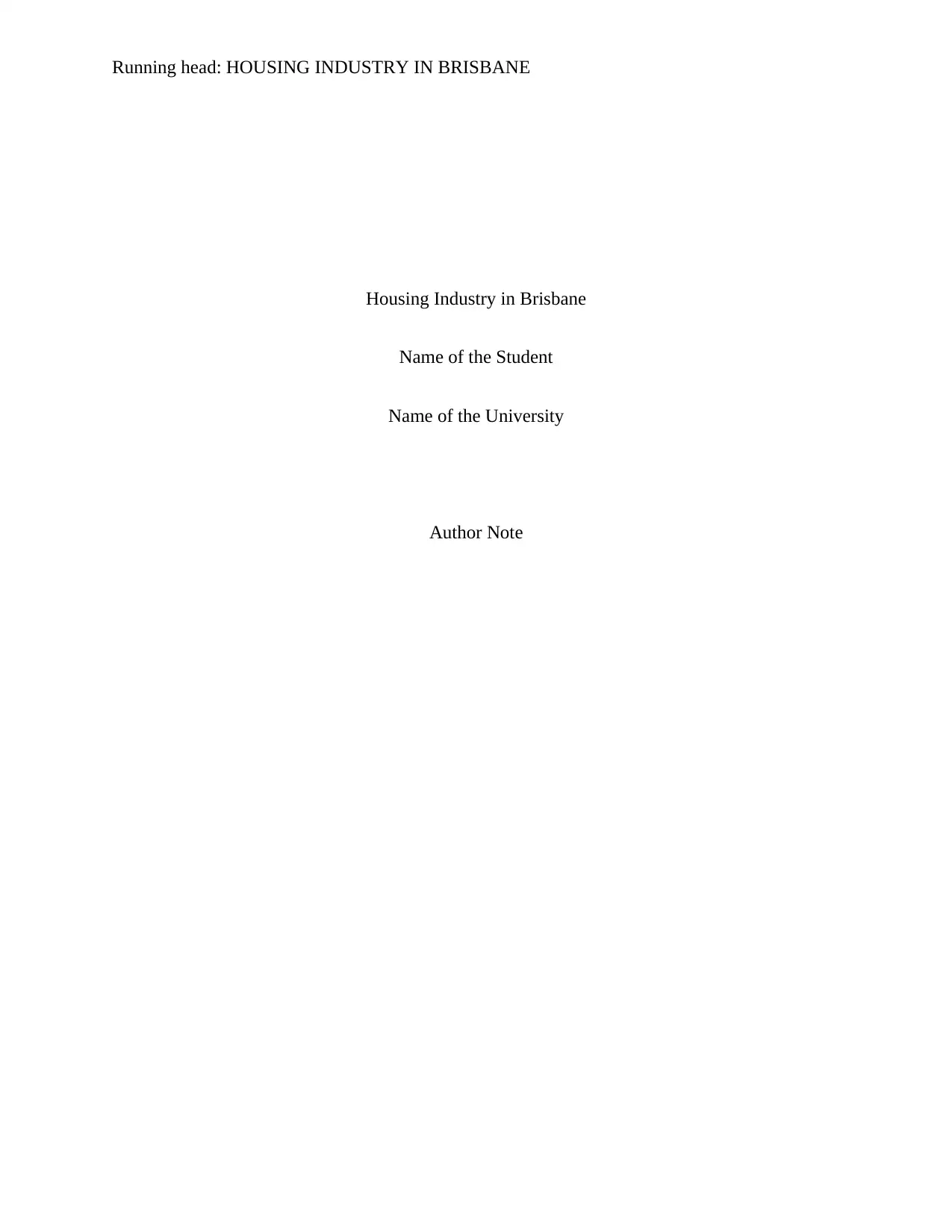
Running head: HOUSING INDUSTRY IN BRISBANE
Housing Industry in Brisbane
Name of the Student
Name of the University
Author Note
Housing Industry in Brisbane
Name of the Student
Name of the University
Author Note
Paraphrase This Document
Need a fresh take? Get an instant paraphrase of this document with our AI Paraphraser
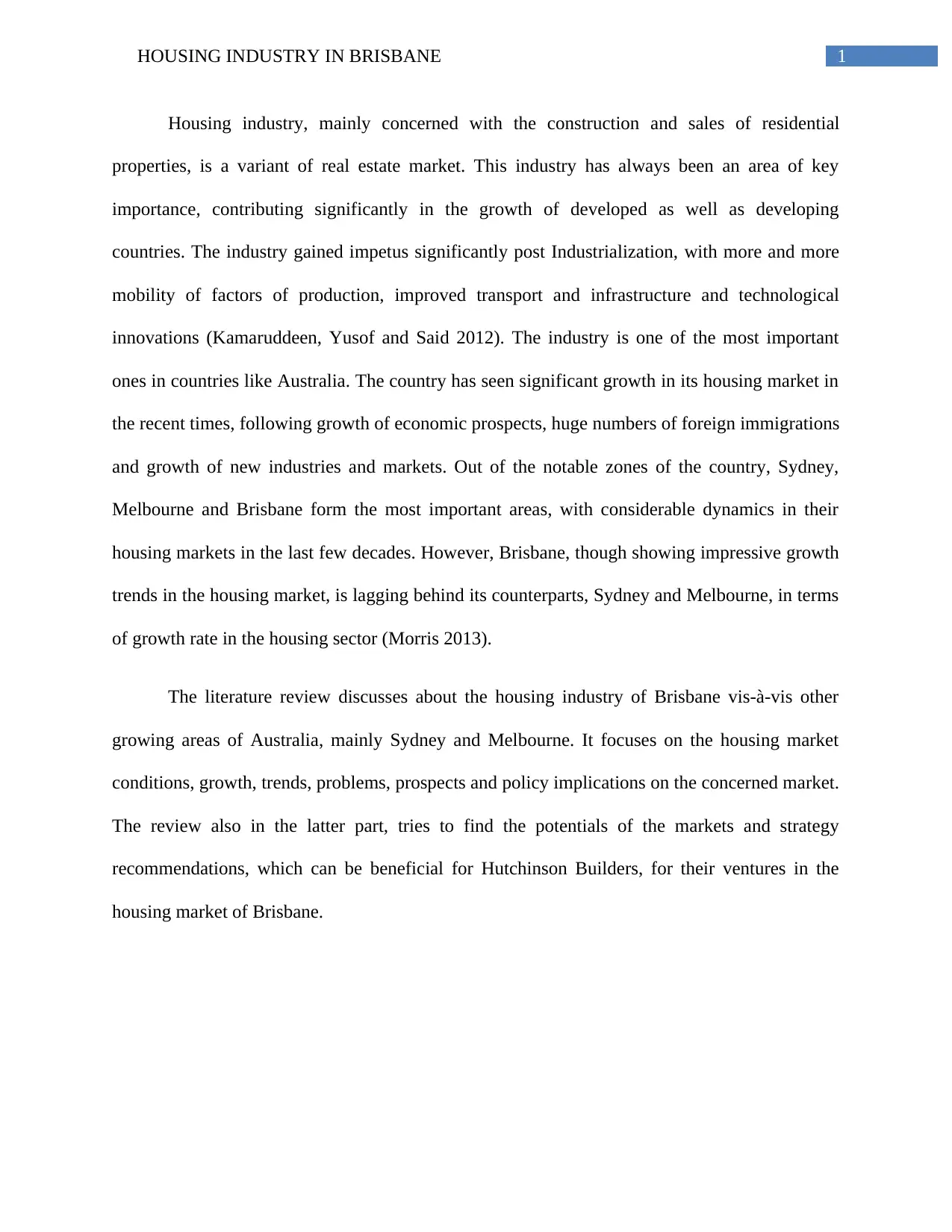
1HOUSING INDUSTRY IN BRISBANE
Housing industry, mainly concerned with the construction and sales of residential
properties, is a variant of real estate market. This industry has always been an area of key
importance, contributing significantly in the growth of developed as well as developing
countries. The industry gained impetus significantly post Industrialization, with more and more
mobility of factors of production, improved transport and infrastructure and technological
innovations (Kamaruddeen, Yusof and Said 2012). The industry is one of the most important
ones in countries like Australia. The country has seen significant growth in its housing market in
the recent times, following growth of economic prospects, huge numbers of foreign immigrations
and growth of new industries and markets. Out of the notable zones of the country, Sydney,
Melbourne and Brisbane form the most important areas, with considerable dynamics in their
housing markets in the last few decades. However, Brisbane, though showing impressive growth
trends in the housing market, is lagging behind its counterparts, Sydney and Melbourne, in terms
of growth rate in the housing sector (Morris 2013).
The literature review discusses about the housing industry of Brisbane vis-à-vis other
growing areas of Australia, mainly Sydney and Melbourne. It focuses on the housing market
conditions, growth, trends, problems, prospects and policy implications on the concerned market.
The review also in the latter part, tries to find the potentials of the markets and strategy
recommendations, which can be beneficial for Hutchinson Builders, for their ventures in the
housing market of Brisbane.
Housing industry, mainly concerned with the construction and sales of residential
properties, is a variant of real estate market. This industry has always been an area of key
importance, contributing significantly in the growth of developed as well as developing
countries. The industry gained impetus significantly post Industrialization, with more and more
mobility of factors of production, improved transport and infrastructure and technological
innovations (Kamaruddeen, Yusof and Said 2012). The industry is one of the most important
ones in countries like Australia. The country has seen significant growth in its housing market in
the recent times, following growth of economic prospects, huge numbers of foreign immigrations
and growth of new industries and markets. Out of the notable zones of the country, Sydney,
Melbourne and Brisbane form the most important areas, with considerable dynamics in their
housing markets in the last few decades. However, Brisbane, though showing impressive growth
trends in the housing market, is lagging behind its counterparts, Sydney and Melbourne, in terms
of growth rate in the housing sector (Morris 2013).
The literature review discusses about the housing industry of Brisbane vis-à-vis other
growing areas of Australia, mainly Sydney and Melbourne. It focuses on the housing market
conditions, growth, trends, problems, prospects and policy implications on the concerned market.
The review also in the latter part, tries to find the potentials of the markets and strategy
recommendations, which can be beneficial for Hutchinson Builders, for their ventures in the
housing market of Brisbane.
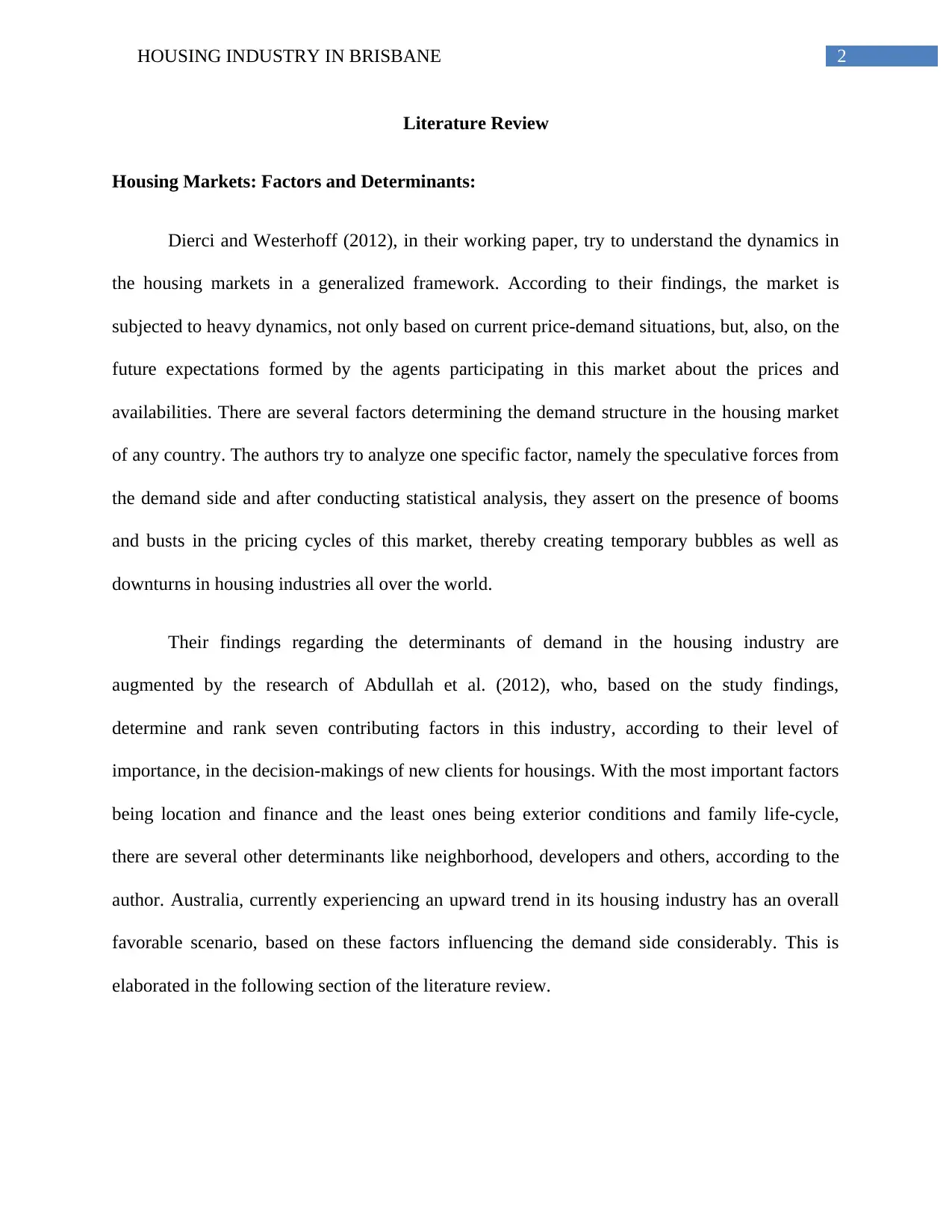
2HOUSING INDUSTRY IN BRISBANE
Literature Review
Housing Markets: Factors and Determinants:
Dierci and Westerhoff (2012), in their working paper, try to understand the dynamics in
the housing markets in a generalized framework. According to their findings, the market is
subjected to heavy dynamics, not only based on current price-demand situations, but, also, on the
future expectations formed by the agents participating in this market about the prices and
availabilities. There are several factors determining the demand structure in the housing market
of any country. The authors try to analyze one specific factor, namely the speculative forces from
the demand side and after conducting statistical analysis, they assert on the presence of booms
and busts in the pricing cycles of this market, thereby creating temporary bubbles as well as
downturns in housing industries all over the world.
Their findings regarding the determinants of demand in the housing industry are
augmented by the research of Abdullah et al. (2012), who, based on the study findings,
determine and rank seven contributing factors in this industry, according to their level of
importance, in the decision-makings of new clients for housings. With the most important factors
being location and finance and the least ones being exterior conditions and family life-cycle,
there are several other determinants like neighborhood, developers and others, according to the
author. Australia, currently experiencing an upward trend in its housing industry has an overall
favorable scenario, based on these factors influencing the demand side considerably. This is
elaborated in the following section of the literature review.
Literature Review
Housing Markets: Factors and Determinants:
Dierci and Westerhoff (2012), in their working paper, try to understand the dynamics in
the housing markets in a generalized framework. According to their findings, the market is
subjected to heavy dynamics, not only based on current price-demand situations, but, also, on the
future expectations formed by the agents participating in this market about the prices and
availabilities. There are several factors determining the demand structure in the housing market
of any country. The authors try to analyze one specific factor, namely the speculative forces from
the demand side and after conducting statistical analysis, they assert on the presence of booms
and busts in the pricing cycles of this market, thereby creating temporary bubbles as well as
downturns in housing industries all over the world.
Their findings regarding the determinants of demand in the housing industry are
augmented by the research of Abdullah et al. (2012), who, based on the study findings,
determine and rank seven contributing factors in this industry, according to their level of
importance, in the decision-makings of new clients for housings. With the most important factors
being location and finance and the least ones being exterior conditions and family life-cycle,
there are several other determinants like neighborhood, developers and others, according to the
author. Australia, currently experiencing an upward trend in its housing industry has an overall
favorable scenario, based on these factors influencing the demand side considerably. This is
elaborated in the following section of the literature review.
⊘ This is a preview!⊘
Do you want full access?
Subscribe today to unlock all pages.

Trusted by 1+ million students worldwide
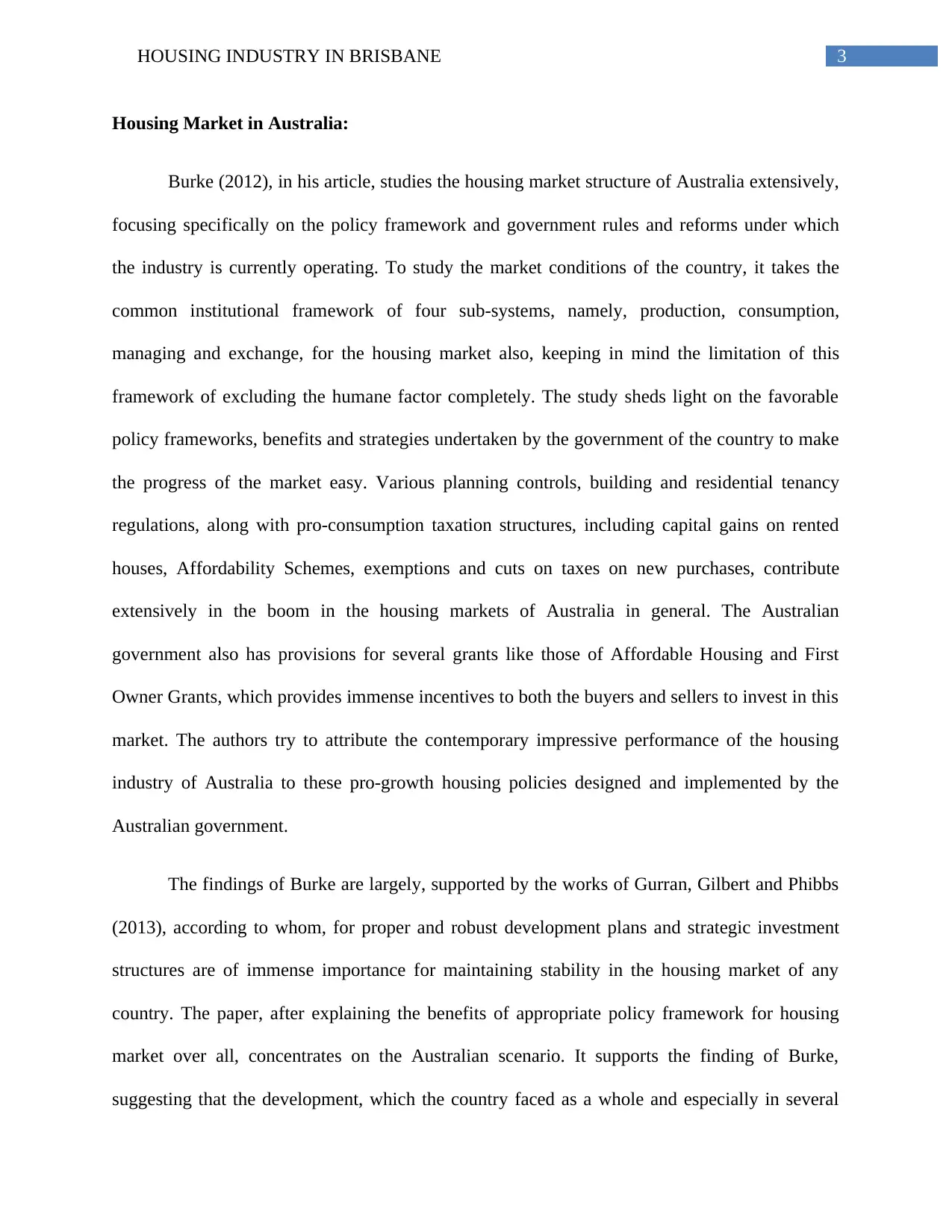
3HOUSING INDUSTRY IN BRISBANE
Housing Market in Australia:
Burke (2012), in his article, studies the housing market structure of Australia extensively,
focusing specifically on the policy framework and government rules and reforms under which
the industry is currently operating. To study the market conditions of the country, it takes the
common institutional framework of four sub-systems, namely, production, consumption,
managing and exchange, for the housing market also, keeping in mind the limitation of this
framework of excluding the humane factor completely. The study sheds light on the favorable
policy frameworks, benefits and strategies undertaken by the government of the country to make
the progress of the market easy. Various planning controls, building and residential tenancy
regulations, along with pro-consumption taxation structures, including capital gains on rented
houses, Affordability Schemes, exemptions and cuts on taxes on new purchases, contribute
extensively in the boom in the housing markets of Australia in general. The Australian
government also has provisions for several grants like those of Affordable Housing and First
Owner Grants, which provides immense incentives to both the buyers and sellers to invest in this
market. The authors try to attribute the contemporary impressive performance of the housing
industry of Australia to these pro-growth housing policies designed and implemented by the
Australian government.
The findings of Burke are largely, supported by the works of Gurran, Gilbert and Phibbs
(2013), according to whom, for proper and robust development plans and strategic investment
structures are of immense importance for maintaining stability in the housing market of any
country. The paper, after explaining the benefits of appropriate policy framework for housing
market over all, concentrates on the Australian scenario. It supports the finding of Burke,
suggesting that the development, which the country faced as a whole and especially in several
Housing Market in Australia:
Burke (2012), in his article, studies the housing market structure of Australia extensively,
focusing specifically on the policy framework and government rules and reforms under which
the industry is currently operating. To study the market conditions of the country, it takes the
common institutional framework of four sub-systems, namely, production, consumption,
managing and exchange, for the housing market also, keeping in mind the limitation of this
framework of excluding the humane factor completely. The study sheds light on the favorable
policy frameworks, benefits and strategies undertaken by the government of the country to make
the progress of the market easy. Various planning controls, building and residential tenancy
regulations, along with pro-consumption taxation structures, including capital gains on rented
houses, Affordability Schemes, exemptions and cuts on taxes on new purchases, contribute
extensively in the boom in the housing markets of Australia in general. The Australian
government also has provisions for several grants like those of Affordable Housing and First
Owner Grants, which provides immense incentives to both the buyers and sellers to invest in this
market. The authors try to attribute the contemporary impressive performance of the housing
industry of Australia to these pro-growth housing policies designed and implemented by the
Australian government.
The findings of Burke are largely, supported by the works of Gurran, Gilbert and Phibbs
(2013), according to whom, for proper and robust development plans and strategic investment
structures are of immense importance for maintaining stability in the housing market of any
country. The paper, after explaining the benefits of appropriate policy framework for housing
market over all, concentrates on the Australian scenario. It supports the finding of Burke,
suggesting that the development, which the country faced as a whole and especially in several
Paraphrase This Document
Need a fresh take? Get an instant paraphrase of this document with our AI Paraphraser
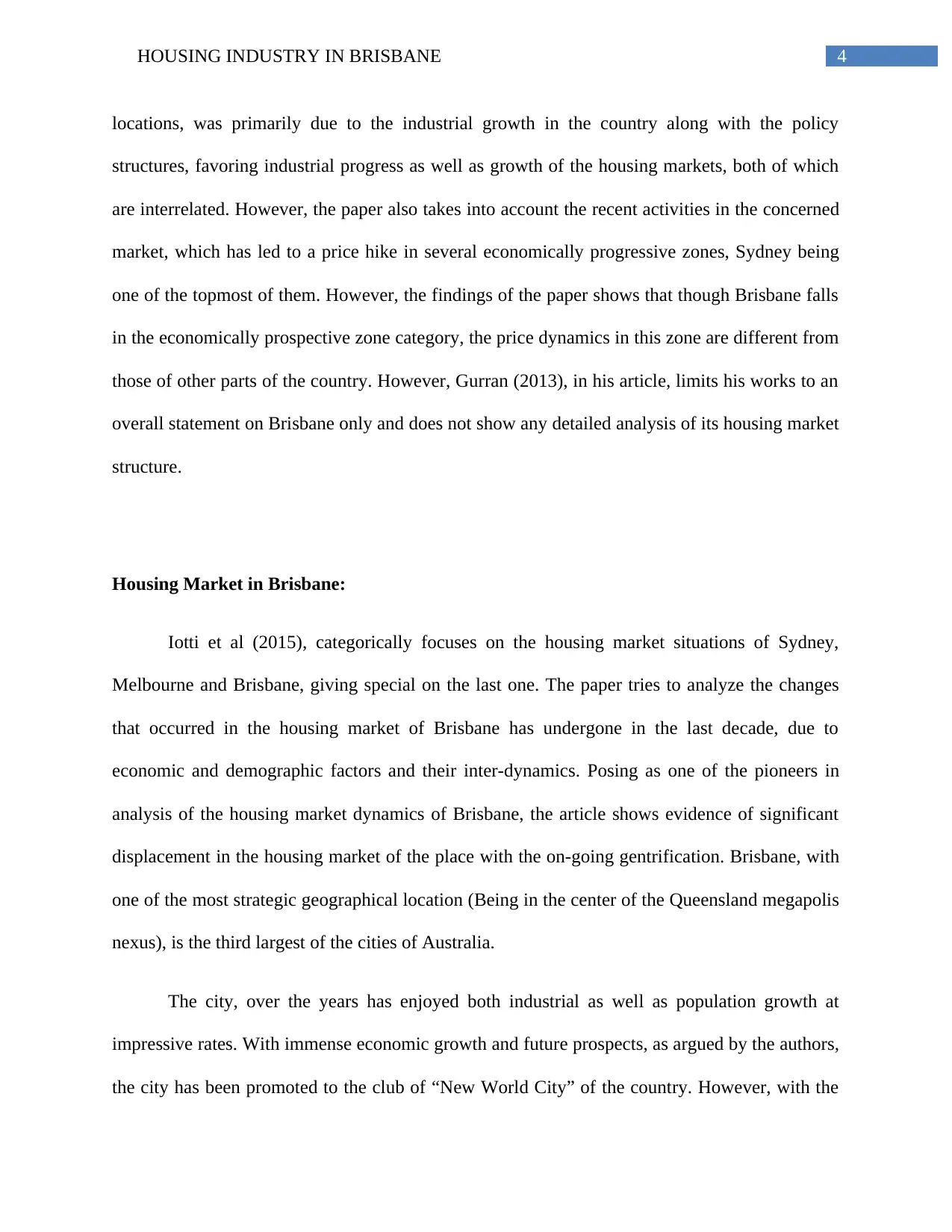
4HOUSING INDUSTRY IN BRISBANE
locations, was primarily due to the industrial growth in the country along with the policy
structures, favoring industrial progress as well as growth of the housing markets, both of which
are interrelated. However, the paper also takes into account the recent activities in the concerned
market, which has led to a price hike in several economically progressive zones, Sydney being
one of the topmost of them. However, the findings of the paper shows that though Brisbane falls
in the economically prospective zone category, the price dynamics in this zone are different from
those of other parts of the country. However, Gurran (2013), in his article, limits his works to an
overall statement on Brisbane only and does not show any detailed analysis of its housing market
structure.
Housing Market in Brisbane:
Iotti et al (2015), categorically focuses on the housing market situations of Sydney,
Melbourne and Brisbane, giving special on the last one. The paper tries to analyze the changes
that occurred in the housing market of Brisbane has undergone in the last decade, due to
economic and demographic factors and their inter-dynamics. Posing as one of the pioneers in
analysis of the housing market dynamics of Brisbane, the article shows evidence of significant
displacement in the housing market of the place with the on-going gentrification. Brisbane, with
one of the most strategic geographical location (Being in the center of the Queensland megapolis
nexus), is the third largest of the cities of Australia.
The city, over the years has enjoyed both industrial as well as population growth at
impressive rates. With immense economic growth and future prospects, as argued by the authors,
the city has been promoted to the club of “New World City” of the country. However, with the
locations, was primarily due to the industrial growth in the country along with the policy
structures, favoring industrial progress as well as growth of the housing markets, both of which
are interrelated. However, the paper also takes into account the recent activities in the concerned
market, which has led to a price hike in several economically progressive zones, Sydney being
one of the topmost of them. However, the findings of the paper shows that though Brisbane falls
in the economically prospective zone category, the price dynamics in this zone are different from
those of other parts of the country. However, Gurran (2013), in his article, limits his works to an
overall statement on Brisbane only and does not show any detailed analysis of its housing market
structure.
Housing Market in Brisbane:
Iotti et al (2015), categorically focuses on the housing market situations of Sydney,
Melbourne and Brisbane, giving special on the last one. The paper tries to analyze the changes
that occurred in the housing market of Brisbane has undergone in the last decade, due to
economic and demographic factors and their inter-dynamics. Posing as one of the pioneers in
analysis of the housing market dynamics of Brisbane, the article shows evidence of significant
displacement in the housing market of the place with the on-going gentrification. Brisbane, with
one of the most strategic geographical location (Being in the center of the Queensland megapolis
nexus), is the third largest of the cities of Australia.
The city, over the years has enjoyed both industrial as well as population growth at
impressive rates. With immense economic growth and future prospects, as argued by the authors,
the city has been promoted to the club of “New World City” of the country. However, with the
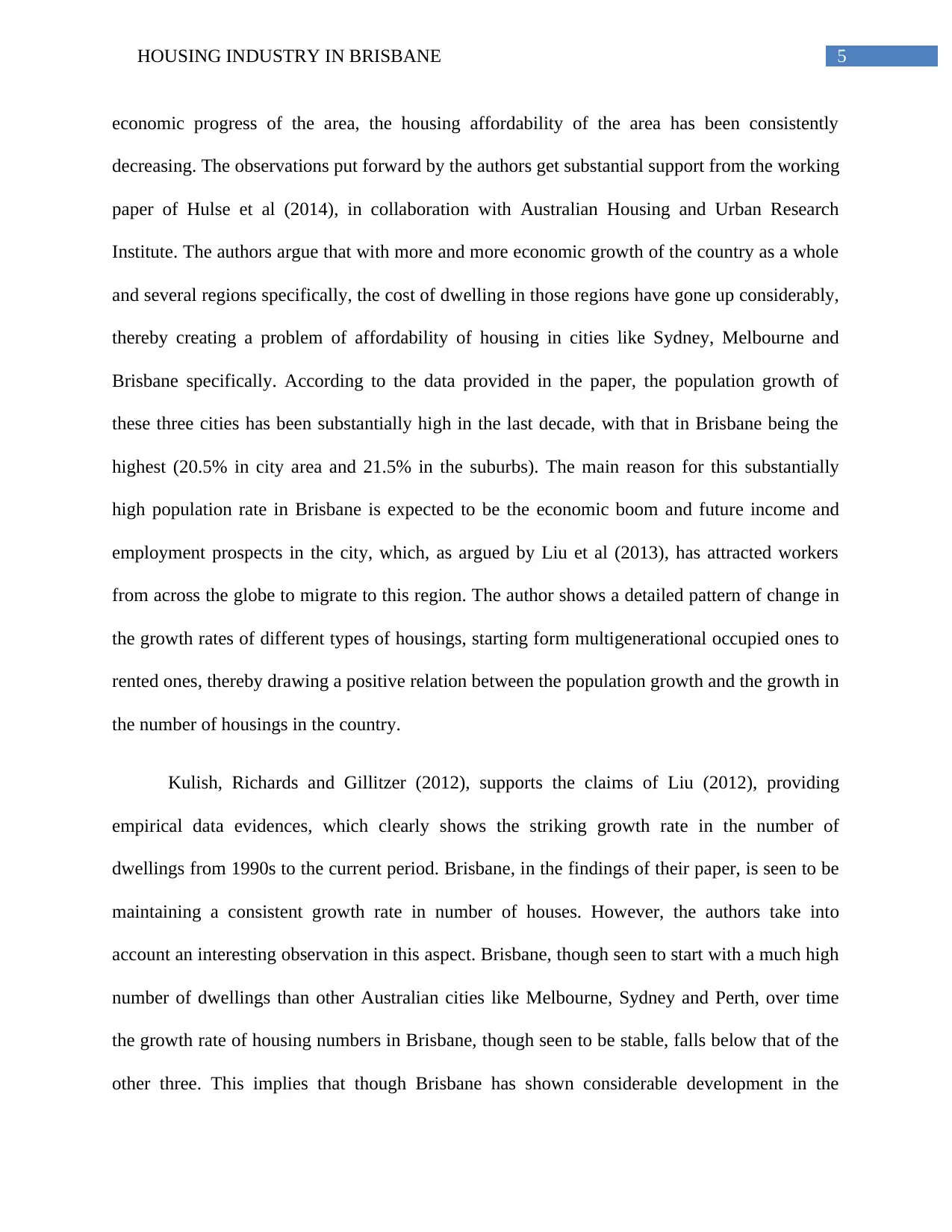
5HOUSING INDUSTRY IN BRISBANE
economic progress of the area, the housing affordability of the area has been consistently
decreasing. The observations put forward by the authors get substantial support from the working
paper of Hulse et al (2014), in collaboration with Australian Housing and Urban Research
Institute. The authors argue that with more and more economic growth of the country as a whole
and several regions specifically, the cost of dwelling in those regions have gone up considerably,
thereby creating a problem of affordability of housing in cities like Sydney, Melbourne and
Brisbane specifically. According to the data provided in the paper, the population growth of
these three cities has been substantially high in the last decade, with that in Brisbane being the
highest (20.5% in city area and 21.5% in the suburbs). The main reason for this substantially
high population rate in Brisbane is expected to be the economic boom and future income and
employment prospects in the city, which, as argued by Liu et al (2013), has attracted workers
from across the globe to migrate to this region. The author shows a detailed pattern of change in
the growth rates of different types of housings, starting form multigenerational occupied ones to
rented ones, thereby drawing a positive relation between the population growth and the growth in
the number of housings in the country.
Kulish, Richards and Gillitzer (2012), supports the claims of Liu (2012), providing
empirical data evidences, which clearly shows the striking growth rate in the number of
dwellings from 1990s to the current period. Brisbane, in the findings of their paper, is seen to be
maintaining a consistent growth rate in number of houses. However, the authors take into
account an interesting observation in this aspect. Brisbane, though seen to start with a much high
number of dwellings than other Australian cities like Melbourne, Sydney and Perth, over time
the growth rate of housing numbers in Brisbane, though seen to be stable, falls below that of the
other three. This implies that though Brisbane has shown considerable development in the
economic progress of the area, the housing affordability of the area has been consistently
decreasing. The observations put forward by the authors get substantial support from the working
paper of Hulse et al (2014), in collaboration with Australian Housing and Urban Research
Institute. The authors argue that with more and more economic growth of the country as a whole
and several regions specifically, the cost of dwelling in those regions have gone up considerably,
thereby creating a problem of affordability of housing in cities like Sydney, Melbourne and
Brisbane specifically. According to the data provided in the paper, the population growth of
these three cities has been substantially high in the last decade, with that in Brisbane being the
highest (20.5% in city area and 21.5% in the suburbs). The main reason for this substantially
high population rate in Brisbane is expected to be the economic boom and future income and
employment prospects in the city, which, as argued by Liu et al (2013), has attracted workers
from across the globe to migrate to this region. The author shows a detailed pattern of change in
the growth rates of different types of housings, starting form multigenerational occupied ones to
rented ones, thereby drawing a positive relation between the population growth and the growth in
the number of housings in the country.
Kulish, Richards and Gillitzer (2012), supports the claims of Liu (2012), providing
empirical data evidences, which clearly shows the striking growth rate in the number of
dwellings from 1990s to the current period. Brisbane, in the findings of their paper, is seen to be
maintaining a consistent growth rate in number of houses. However, the authors take into
account an interesting observation in this aspect. Brisbane, though seen to start with a much high
number of dwellings than other Australian cities like Melbourne, Sydney and Perth, over time
the growth rate of housing numbers in Brisbane, though seen to be stable, falls below that of the
other three. This implies that though Brisbane has shown considerable development in the
⊘ This is a preview!⊘
Do you want full access?
Subscribe today to unlock all pages.

Trusted by 1+ million students worldwide
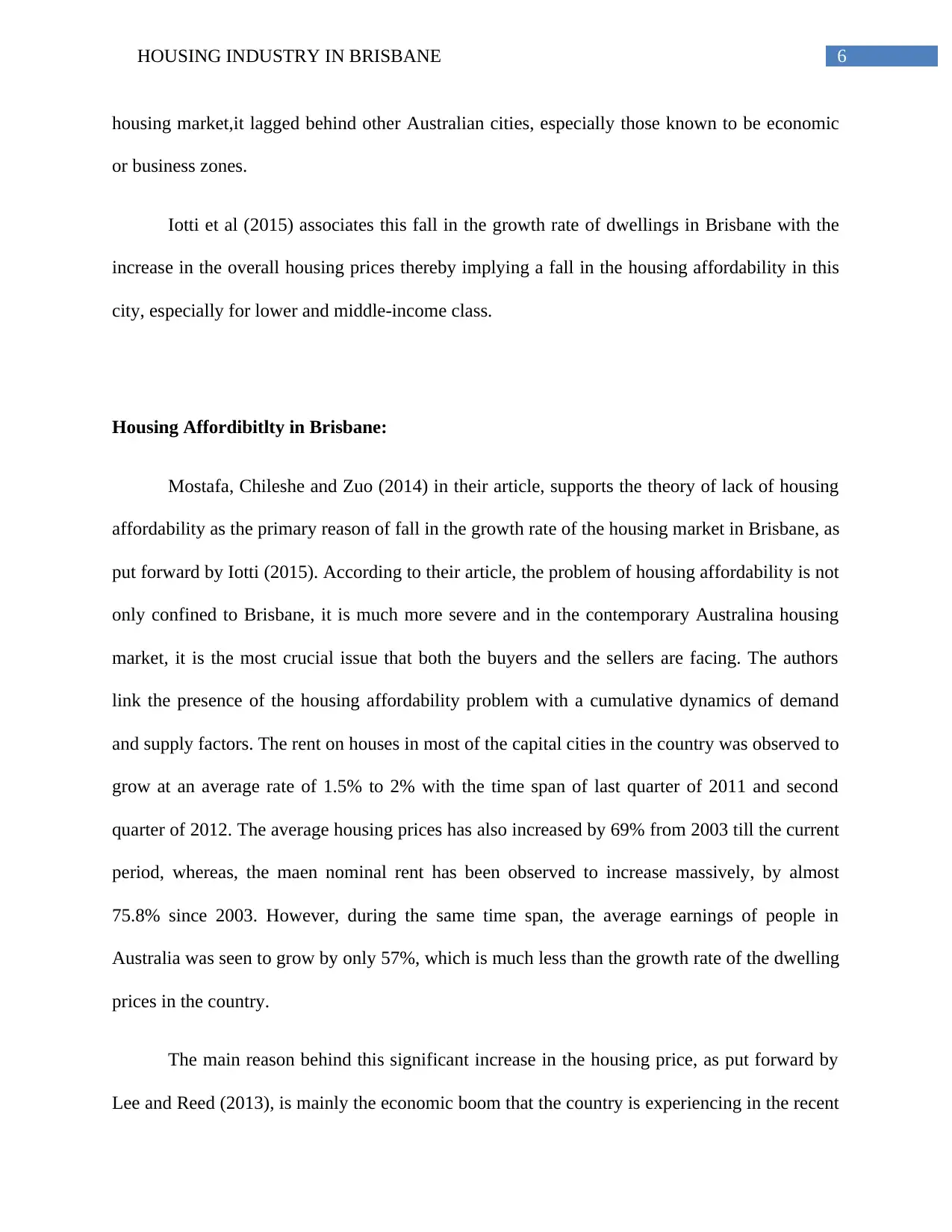
6HOUSING INDUSTRY IN BRISBANE
housing market,it lagged behind other Australian cities, especially those known to be economic
or business zones.
Iotti et al (2015) associates this fall in the growth rate of dwellings in Brisbane with the
increase in the overall housing prices thereby implying a fall in the housing affordability in this
city, especially for lower and middle-income class.
Housing Affordibitlty in Brisbane:
Mostafa, Chileshe and Zuo (2014) in their article, supports the theory of lack of housing
affordability as the primary reason of fall in the growth rate of the housing market in Brisbane, as
put forward by Iotti (2015). According to their article, the problem of housing affordability is not
only confined to Brisbane, it is much more severe and in the contemporary Australina housing
market, it is the most crucial issue that both the buyers and the sellers are facing. The authors
link the presence of the housing affordability problem with a cumulative dynamics of demand
and supply factors. The rent on houses in most of the capital cities in the country was observed to
grow at an average rate of 1.5% to 2% with the time span of last quarter of 2011 and second
quarter of 2012. The average housing prices has also increased by 69% from 2003 till the current
period, whereas, the maen nominal rent has been observed to increase massively, by almost
75.8% since 2003. However, during the same time span, the average earnings of people in
Australia was seen to grow by only 57%, which is much less than the growth rate of the dwelling
prices in the country.
The main reason behind this significant increase in the housing price, as put forward by
Lee and Reed (2013), is mainly the economic boom that the country is experiencing in the recent
housing market,it lagged behind other Australian cities, especially those known to be economic
or business zones.
Iotti et al (2015) associates this fall in the growth rate of dwellings in Brisbane with the
increase in the overall housing prices thereby implying a fall in the housing affordability in this
city, especially for lower and middle-income class.
Housing Affordibitlty in Brisbane:
Mostafa, Chileshe and Zuo (2014) in their article, supports the theory of lack of housing
affordability as the primary reason of fall in the growth rate of the housing market in Brisbane, as
put forward by Iotti (2015). According to their article, the problem of housing affordability is not
only confined to Brisbane, it is much more severe and in the contemporary Australina housing
market, it is the most crucial issue that both the buyers and the sellers are facing. The authors
link the presence of the housing affordability problem with a cumulative dynamics of demand
and supply factors. The rent on houses in most of the capital cities in the country was observed to
grow at an average rate of 1.5% to 2% with the time span of last quarter of 2011 and second
quarter of 2012. The average housing prices has also increased by 69% from 2003 till the current
period, whereas, the maen nominal rent has been observed to increase massively, by almost
75.8% since 2003. However, during the same time span, the average earnings of people in
Australia was seen to grow by only 57%, which is much less than the growth rate of the dwelling
prices in the country.
The main reason behind this significant increase in the housing price, as put forward by
Lee and Reed (2013), is mainly the economic boom that the country is experiencing in the recent
Paraphrase This Document
Need a fresh take? Get an instant paraphrase of this document with our AI Paraphraser
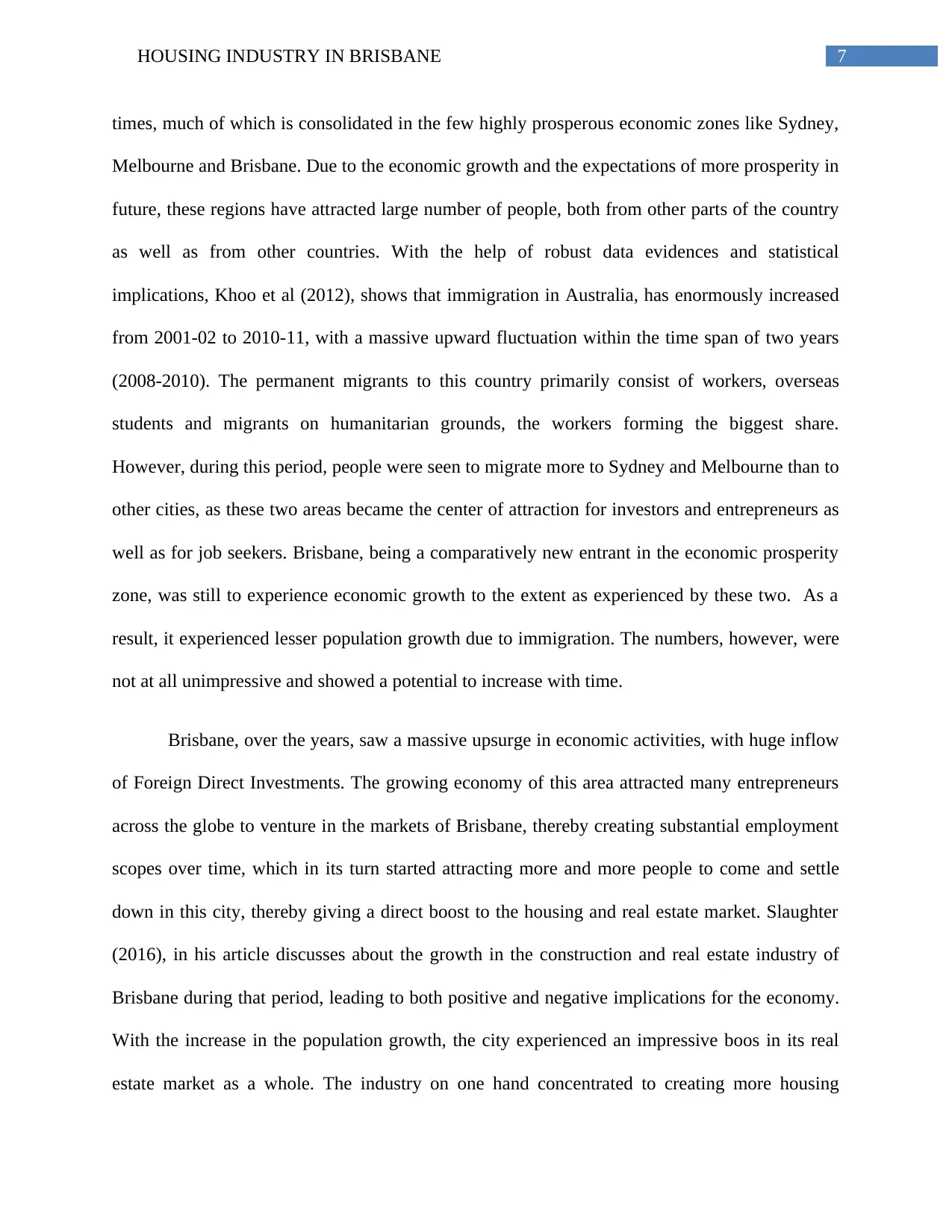
7HOUSING INDUSTRY IN BRISBANE
times, much of which is consolidated in the few highly prosperous economic zones like Sydney,
Melbourne and Brisbane. Due to the economic growth and the expectations of more prosperity in
future, these regions have attracted large number of people, both from other parts of the country
as well as from other countries. With the help of robust data evidences and statistical
implications, Khoo et al (2012), shows that immigration in Australia, has enormously increased
from 2001-02 to 2010-11, with a massive upward fluctuation within the time span of two years
(2008-2010). The permanent migrants to this country primarily consist of workers, overseas
students and migrants on humanitarian grounds, the workers forming the biggest share.
However, during this period, people were seen to migrate more to Sydney and Melbourne than to
other cities, as these two areas became the center of attraction for investors and entrepreneurs as
well as for job seekers. Brisbane, being a comparatively new entrant in the economic prosperity
zone, was still to experience economic growth to the extent as experienced by these two. As a
result, it experienced lesser population growth due to immigration. The numbers, however, were
not at all unimpressive and showed a potential to increase with time.
Brisbane, over the years, saw a massive upsurge in economic activities, with huge inflow
of Foreign Direct Investments. The growing economy of this area attracted many entrepreneurs
across the globe to venture in the markets of Brisbane, thereby creating substantial employment
scopes over time, which in its turn started attracting more and more people to come and settle
down in this city, thereby giving a direct boost to the housing and real estate market. Slaughter
(2016), in his article discusses about the growth in the construction and real estate industry of
Brisbane during that period, leading to both positive and negative implications for the economy.
With the increase in the population growth, the city experienced an impressive boos in its real
estate market as a whole. The industry on one hand concentrated to creating more housing
times, much of which is consolidated in the few highly prosperous economic zones like Sydney,
Melbourne and Brisbane. Due to the economic growth and the expectations of more prosperity in
future, these regions have attracted large number of people, both from other parts of the country
as well as from other countries. With the help of robust data evidences and statistical
implications, Khoo et al (2012), shows that immigration in Australia, has enormously increased
from 2001-02 to 2010-11, with a massive upward fluctuation within the time span of two years
(2008-2010). The permanent migrants to this country primarily consist of workers, overseas
students and migrants on humanitarian grounds, the workers forming the biggest share.
However, during this period, people were seen to migrate more to Sydney and Melbourne than to
other cities, as these two areas became the center of attraction for investors and entrepreneurs as
well as for job seekers. Brisbane, being a comparatively new entrant in the economic prosperity
zone, was still to experience economic growth to the extent as experienced by these two. As a
result, it experienced lesser population growth due to immigration. The numbers, however, were
not at all unimpressive and showed a potential to increase with time.
Brisbane, over the years, saw a massive upsurge in economic activities, with huge inflow
of Foreign Direct Investments. The growing economy of this area attracted many entrepreneurs
across the globe to venture in the markets of Brisbane, thereby creating substantial employment
scopes over time, which in its turn started attracting more and more people to come and settle
down in this city, thereby giving a direct boost to the housing and real estate market. Slaughter
(2016), in his article discusses about the growth in the construction and real estate industry of
Brisbane during that period, leading to both positive and negative implications for the economy.
With the increase in the population growth, the city experienced an impressive boos in its real
estate market as a whole. The industry on one hand concentrated to creating more housing
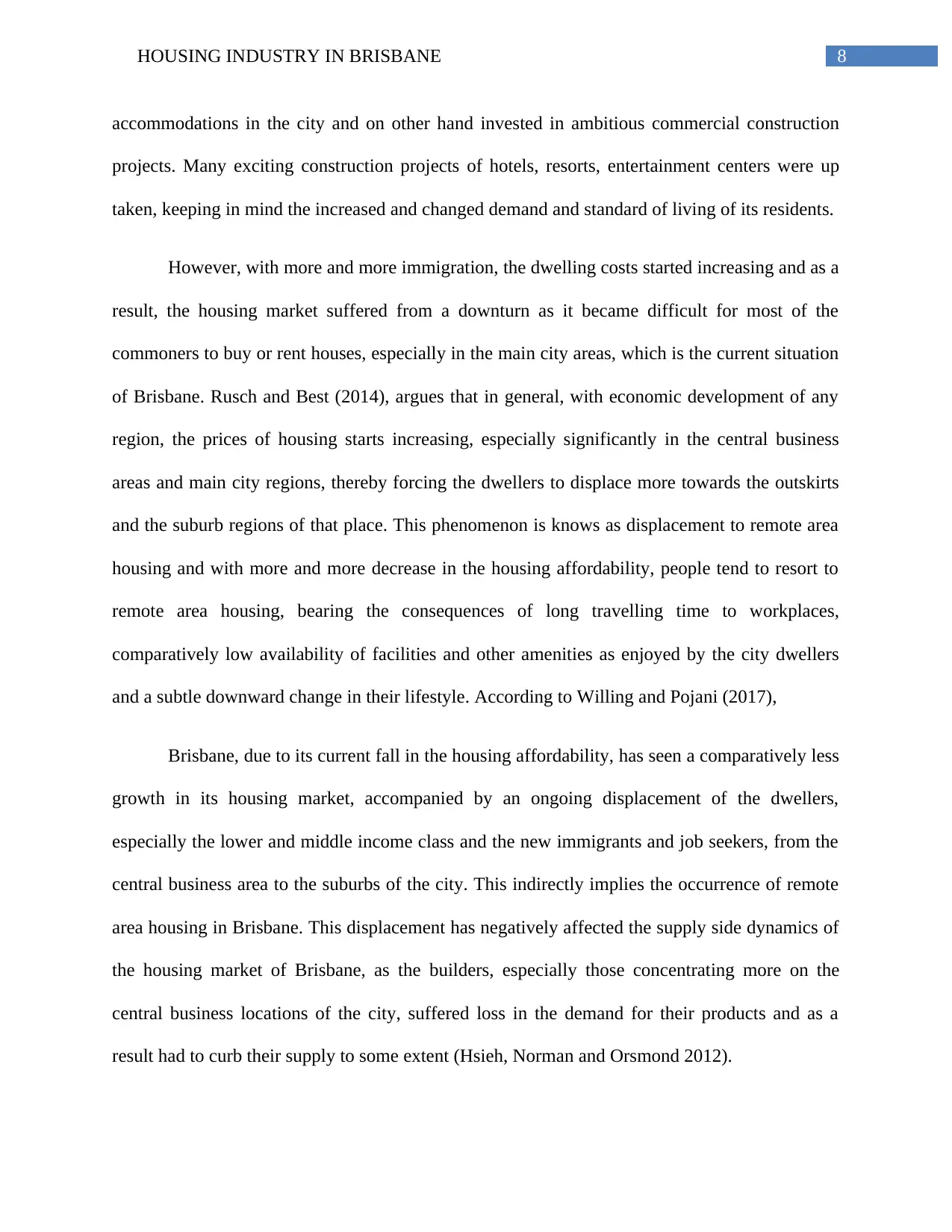
8HOUSING INDUSTRY IN BRISBANE
accommodations in the city and on other hand invested in ambitious commercial construction
projects. Many exciting construction projects of hotels, resorts, entertainment centers were up
taken, keeping in mind the increased and changed demand and standard of living of its residents.
However, with more and more immigration, the dwelling costs started increasing and as a
result, the housing market suffered from a downturn as it became difficult for most of the
commoners to buy or rent houses, especially in the main city areas, which is the current situation
of Brisbane. Rusch and Best (2014), argues that in general, with economic development of any
region, the prices of housing starts increasing, especially significantly in the central business
areas and main city regions, thereby forcing the dwellers to displace more towards the outskirts
and the suburb regions of that place. This phenomenon is knows as displacement to remote area
housing and with more and more decrease in the housing affordability, people tend to resort to
remote area housing, bearing the consequences of long travelling time to workplaces,
comparatively low availability of facilities and other amenities as enjoyed by the city dwellers
and a subtle downward change in their lifestyle. According to Willing and Pojani (2017),
Brisbane, due to its current fall in the housing affordability, has seen a comparatively less
growth in its housing market, accompanied by an ongoing displacement of the dwellers,
especially the lower and middle income class and the new immigrants and job seekers, from the
central business area to the suburbs of the city. This indirectly implies the occurrence of remote
area housing in Brisbane. This displacement has negatively affected the supply side dynamics of
the housing market of Brisbane, as the builders, especially those concentrating more on the
central business locations of the city, suffered loss in the demand for their products and as a
result had to curb their supply to some extent (Hsieh, Norman and Orsmond 2012).
accommodations in the city and on other hand invested in ambitious commercial construction
projects. Many exciting construction projects of hotels, resorts, entertainment centers were up
taken, keeping in mind the increased and changed demand and standard of living of its residents.
However, with more and more immigration, the dwelling costs started increasing and as a
result, the housing market suffered from a downturn as it became difficult for most of the
commoners to buy or rent houses, especially in the main city areas, which is the current situation
of Brisbane. Rusch and Best (2014), argues that in general, with economic development of any
region, the prices of housing starts increasing, especially significantly in the central business
areas and main city regions, thereby forcing the dwellers to displace more towards the outskirts
and the suburb regions of that place. This phenomenon is knows as displacement to remote area
housing and with more and more decrease in the housing affordability, people tend to resort to
remote area housing, bearing the consequences of long travelling time to workplaces,
comparatively low availability of facilities and other amenities as enjoyed by the city dwellers
and a subtle downward change in their lifestyle. According to Willing and Pojani (2017),
Brisbane, due to its current fall in the housing affordability, has seen a comparatively less
growth in its housing market, accompanied by an ongoing displacement of the dwellers,
especially the lower and middle income class and the new immigrants and job seekers, from the
central business area to the suburbs of the city. This indirectly implies the occurrence of remote
area housing in Brisbane. This displacement has negatively affected the supply side dynamics of
the housing market of Brisbane, as the builders, especially those concentrating more on the
central business locations of the city, suffered loss in the demand for their products and as a
result had to curb their supply to some extent (Hsieh, Norman and Orsmond 2012).
⊘ This is a preview!⊘
Do you want full access?
Subscribe today to unlock all pages.

Trusted by 1+ million students worldwide
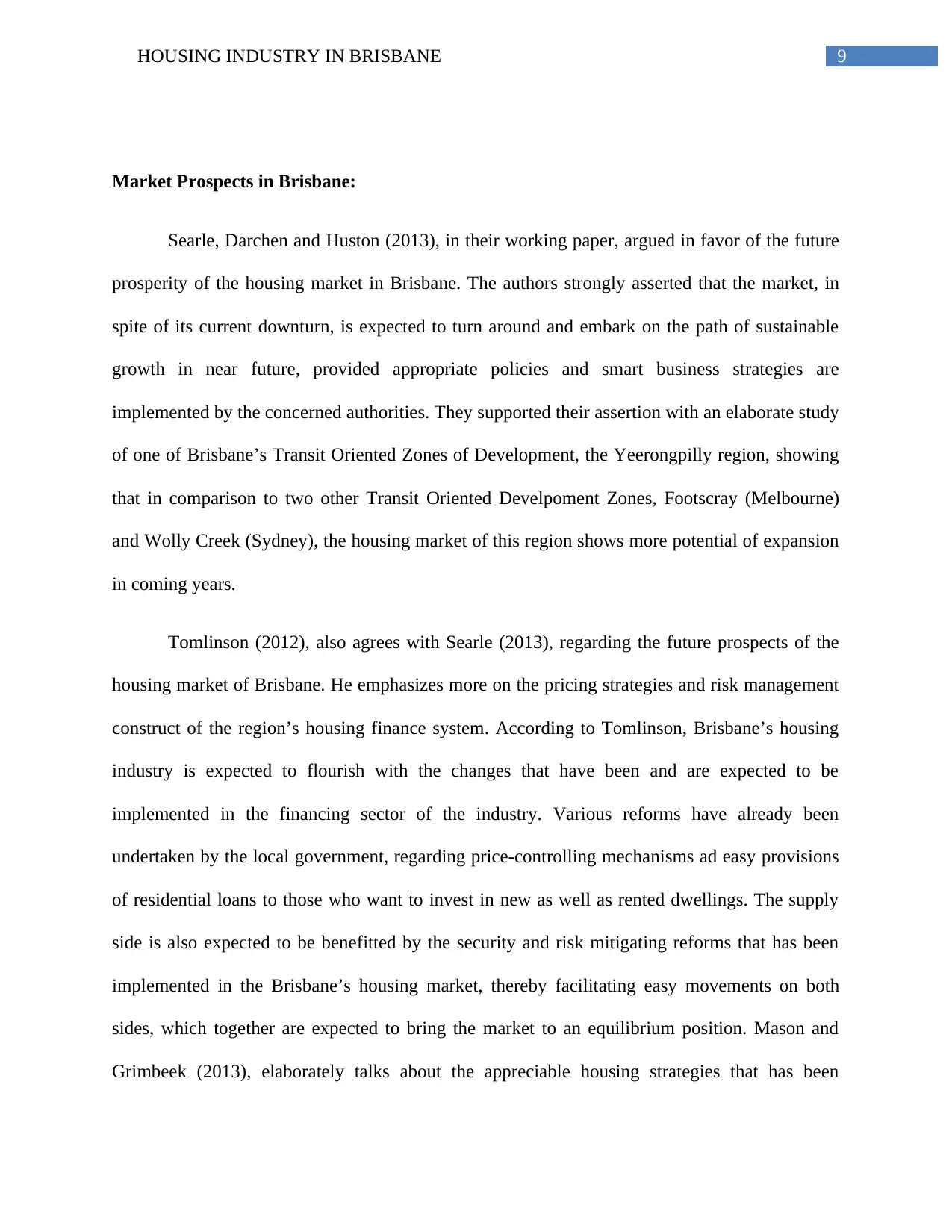
9HOUSING INDUSTRY IN BRISBANE
Market Prospects in Brisbane:
Searle, Darchen and Huston (2013), in their working paper, argued in favor of the future
prosperity of the housing market in Brisbane. The authors strongly asserted that the market, in
spite of its current downturn, is expected to turn around and embark on the path of sustainable
growth in near future, provided appropriate policies and smart business strategies are
implemented by the concerned authorities. They supported their assertion with an elaborate study
of one of Brisbane’s Transit Oriented Zones of Development, the Yeerongpilly region, showing
that in comparison to two other Transit Oriented Develpoment Zones, Footscray (Melbourne)
and Wolly Creek (Sydney), the housing market of this region shows more potential of expansion
in coming years.
Tomlinson (2012), also agrees with Searle (2013), regarding the future prospects of the
housing market of Brisbane. He emphasizes more on the pricing strategies and risk management
construct of the region’s housing finance system. According to Tomlinson, Brisbane’s housing
industry is expected to flourish with the changes that have been and are expected to be
implemented in the financing sector of the industry. Various reforms have already been
undertaken by the local government, regarding price-controlling mechanisms ad easy provisions
of residential loans to those who want to invest in new as well as rented dwellings. The supply
side is also expected to be benefitted by the security and risk mitigating reforms that has been
implemented in the Brisbane’s housing market, thereby facilitating easy movements on both
sides, which together are expected to bring the market to an equilibrium position. Mason and
Grimbeek (2013), elaborately talks about the appreciable housing strategies that has been
Market Prospects in Brisbane:
Searle, Darchen and Huston (2013), in their working paper, argued in favor of the future
prosperity of the housing market in Brisbane. The authors strongly asserted that the market, in
spite of its current downturn, is expected to turn around and embark on the path of sustainable
growth in near future, provided appropriate policies and smart business strategies are
implemented by the concerned authorities. They supported their assertion with an elaborate study
of one of Brisbane’s Transit Oriented Zones of Development, the Yeerongpilly region, showing
that in comparison to two other Transit Oriented Develpoment Zones, Footscray (Melbourne)
and Wolly Creek (Sydney), the housing market of this region shows more potential of expansion
in coming years.
Tomlinson (2012), also agrees with Searle (2013), regarding the future prospects of the
housing market of Brisbane. He emphasizes more on the pricing strategies and risk management
construct of the region’s housing finance system. According to Tomlinson, Brisbane’s housing
industry is expected to flourish with the changes that have been and are expected to be
implemented in the financing sector of the industry. Various reforms have already been
undertaken by the local government, regarding price-controlling mechanisms ad easy provisions
of residential loans to those who want to invest in new as well as rented dwellings. The supply
side is also expected to be benefitted by the security and risk mitigating reforms that has been
implemented in the Brisbane’s housing market, thereby facilitating easy movements on both
sides, which together are expected to bring the market to an equilibrium position. Mason and
Grimbeek (2013), elaborately talks about the appreciable housing strategies that has been
Paraphrase This Document
Need a fresh take? Get an instant paraphrase of this document with our AI Paraphraser
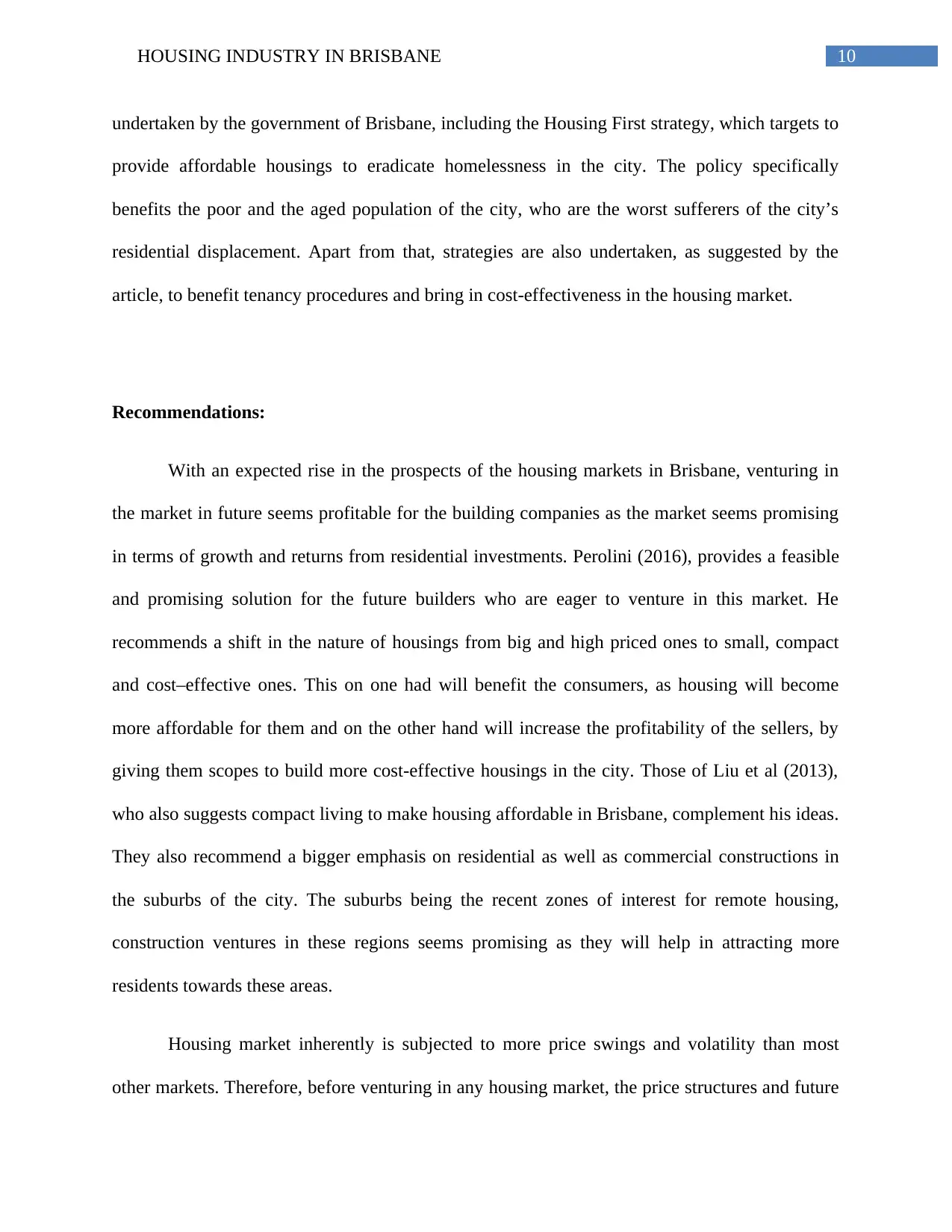
10HOUSING INDUSTRY IN BRISBANE
undertaken by the government of Brisbane, including the Housing First strategy, which targets to
provide affordable housings to eradicate homelessness in the city. The policy specifically
benefits the poor and the aged population of the city, who are the worst sufferers of the city’s
residential displacement. Apart from that, strategies are also undertaken, as suggested by the
article, to benefit tenancy procedures and bring in cost-effectiveness in the housing market.
Recommendations:
With an expected rise in the prospects of the housing markets in Brisbane, venturing in
the market in future seems profitable for the building companies as the market seems promising
in terms of growth and returns from residential investments. Perolini (2016), provides a feasible
and promising solution for the future builders who are eager to venture in this market. He
recommends a shift in the nature of housings from big and high priced ones to small, compact
and cost–effective ones. This on one had will benefit the consumers, as housing will become
more affordable for them and on the other hand will increase the profitability of the sellers, by
giving them scopes to build more cost-effective housings in the city. Those of Liu et al (2013),
who also suggests compact living to make housing affordable in Brisbane, complement his ideas.
They also recommend a bigger emphasis on residential as well as commercial constructions in
the suburbs of the city. The suburbs being the recent zones of interest for remote housing,
construction ventures in these regions seems promising as they will help in attracting more
residents towards these areas.
Housing market inherently is subjected to more price swings and volatility than most
other markets. Therefore, before venturing in any housing market, the price structures and future
undertaken by the government of Brisbane, including the Housing First strategy, which targets to
provide affordable housings to eradicate homelessness in the city. The policy specifically
benefits the poor and the aged population of the city, who are the worst sufferers of the city’s
residential displacement. Apart from that, strategies are also undertaken, as suggested by the
article, to benefit tenancy procedures and bring in cost-effectiveness in the housing market.
Recommendations:
With an expected rise in the prospects of the housing markets in Brisbane, venturing in
the market in future seems profitable for the building companies as the market seems promising
in terms of growth and returns from residential investments. Perolini (2016), provides a feasible
and promising solution for the future builders who are eager to venture in this market. He
recommends a shift in the nature of housings from big and high priced ones to small, compact
and cost–effective ones. This on one had will benefit the consumers, as housing will become
more affordable for them and on the other hand will increase the profitability of the sellers, by
giving them scopes to build more cost-effective housings in the city. Those of Liu et al (2013),
who also suggests compact living to make housing affordable in Brisbane, complement his ideas.
They also recommend a bigger emphasis on residential as well as commercial constructions in
the suburbs of the city. The suburbs being the recent zones of interest for remote housing,
construction ventures in these regions seems promising as they will help in attracting more
residents towards these areas.
Housing market inherently is subjected to more price swings and volatility than most
other markets. Therefore, before venturing in any housing market, the price structures and future
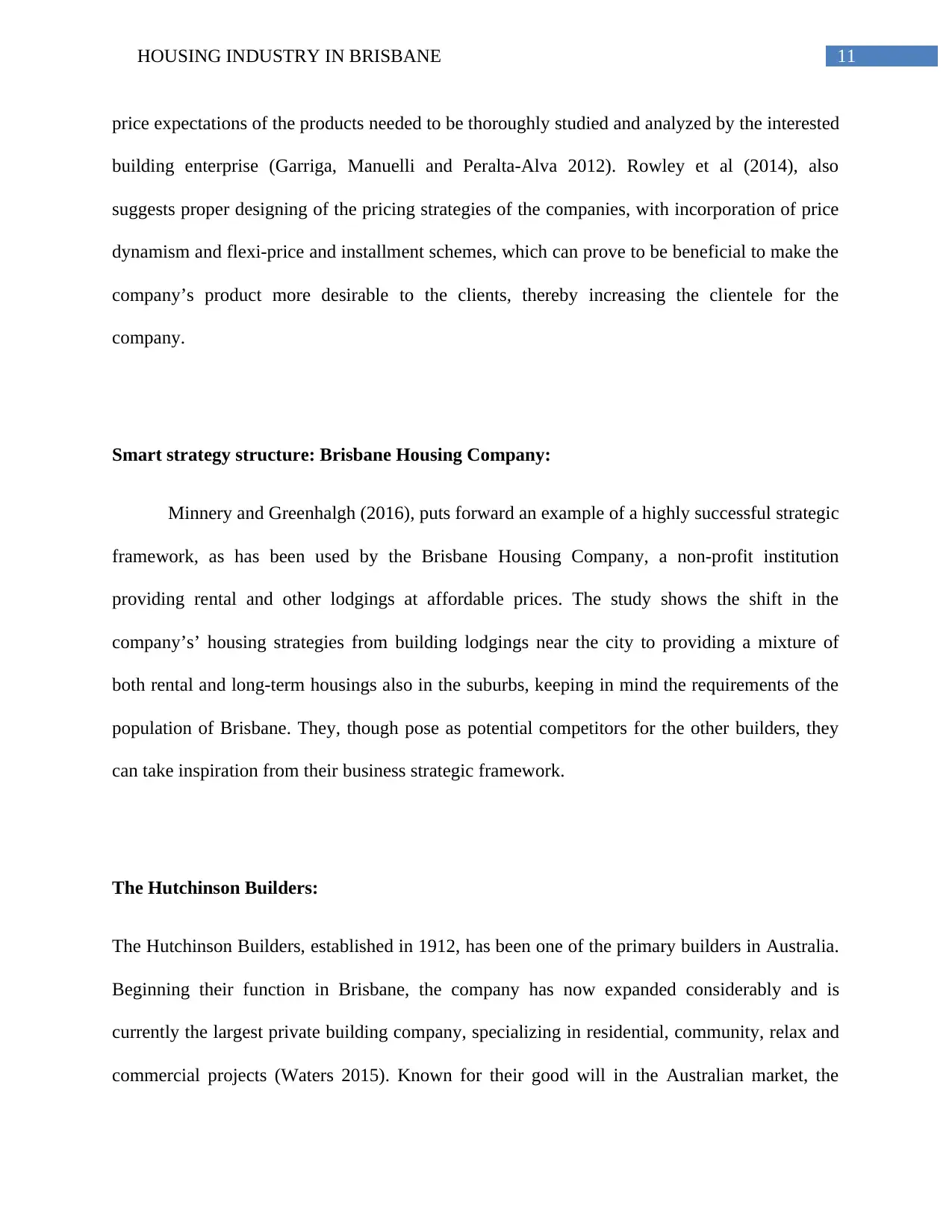
11HOUSING INDUSTRY IN BRISBANE
price expectations of the products needed to be thoroughly studied and analyzed by the interested
building enterprise (Garriga, Manuelli and Peralta-Alva 2012). Rowley et al (2014), also
suggests proper designing of the pricing strategies of the companies, with incorporation of price
dynamism and flexi-price and installment schemes, which can prove to be beneficial to make the
company’s product more desirable to the clients, thereby increasing the clientele for the
company.
Smart strategy structure: Brisbane Housing Company:
Minnery and Greenhalgh (2016), puts forward an example of a highly successful strategic
framework, as has been used by the Brisbane Housing Company, a non-profit institution
providing rental and other lodgings at affordable prices. The study shows the shift in the
company’s’ housing strategies from building lodgings near the city to providing a mixture of
both rental and long-term housings also in the suburbs, keeping in mind the requirements of the
population of Brisbane. They, though pose as potential competitors for the other builders, they
can take inspiration from their business strategic framework.
The Hutchinson Builders:
The Hutchinson Builders, established in 1912, has been one of the primary builders in Australia.
Beginning their function in Brisbane, the company has now expanded considerably and is
currently the largest private building company, specializing in residential, community, relax and
commercial projects (Waters 2015). Known for their good will in the Australian market, the
price expectations of the products needed to be thoroughly studied and analyzed by the interested
building enterprise (Garriga, Manuelli and Peralta-Alva 2012). Rowley et al (2014), also
suggests proper designing of the pricing strategies of the companies, with incorporation of price
dynamism and flexi-price and installment schemes, which can prove to be beneficial to make the
company’s product more desirable to the clients, thereby increasing the clientele for the
company.
Smart strategy structure: Brisbane Housing Company:
Minnery and Greenhalgh (2016), puts forward an example of a highly successful strategic
framework, as has been used by the Brisbane Housing Company, a non-profit institution
providing rental and other lodgings at affordable prices. The study shows the shift in the
company’s’ housing strategies from building lodgings near the city to providing a mixture of
both rental and long-term housings also in the suburbs, keeping in mind the requirements of the
population of Brisbane. They, though pose as potential competitors for the other builders, they
can take inspiration from their business strategic framework.
The Hutchinson Builders:
The Hutchinson Builders, established in 1912, has been one of the primary builders in Australia.
Beginning their function in Brisbane, the company has now expanded considerably and is
currently the largest private building company, specializing in residential, community, relax and
commercial projects (Waters 2015). Known for their good will in the Australian market, the
⊘ This is a preview!⊘
Do you want full access?
Subscribe today to unlock all pages.

Trusted by 1+ million students worldwide
1 out of 16
Related Documents
Your All-in-One AI-Powered Toolkit for Academic Success.
+13062052269
info@desklib.com
Available 24*7 on WhatsApp / Email
![[object Object]](/_next/static/media/star-bottom.7253800d.svg)
Unlock your academic potential
Copyright © 2020–2025 A2Z Services. All Rights Reserved. Developed and managed by ZUCOL.





